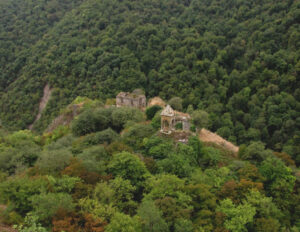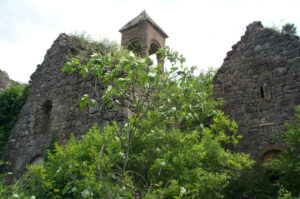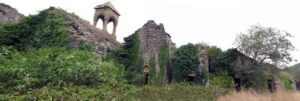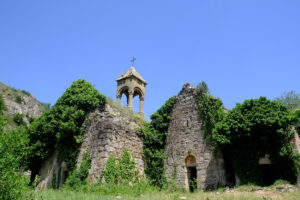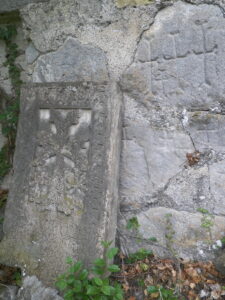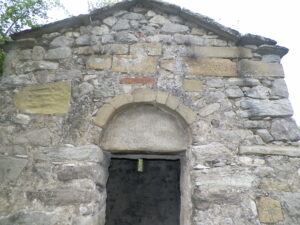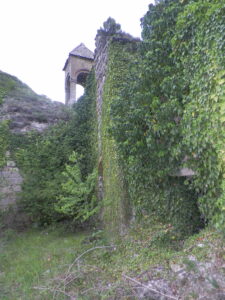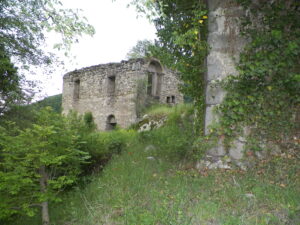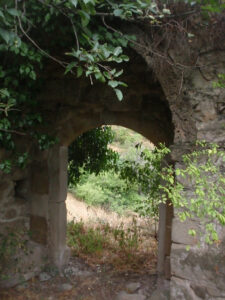The Monastery of the Apostle St.Yeghishe
Martakert Province, Mataghis
The Monastery of the Apostle St.Yeghishe is one of the oldest Armenian monasteries. According to M.Kagankatvatsi, the monastery was located in the ancient sanctuary, before the martyrdom of the disciple of the Apostle Thaddeus Yeghishe, and was buried here. The sanctuary was called the Holy Covenant of Nersmihr. According to the historian Movses Kagankatvatsi, in the second half of the 5th century, the pious King Vachagan King of the Armenian East acquired the relics of the Apostle Yeghishe, moved them to Artsakh, buried them on a high mountain, and built a chapel-tomb on the grave, where he was buried. After the conversion to Christianity, the sanctuary became Christian and was called Jrvshtik, after the Jrvshtik waterfall near the monastery. Yeghishe Apostolic Monastery was a Catholicosate, episcopate, and in recent centuries was known for its heroic monks (High Priest, Dali Mahrasa).
Yeghishe Apostolic monastery complex consists of a church, a vestibule, a refectory, 7 chapels, monastic-diocesan buildings, a number of residential and economic buildings, surrounded by walls.The main church of the monastery, which is a vaulted hall, was built in XII-XIII centuries. The church has been rebuilt many times throughout its history, as evidenced by the older stones used in the masonry, on which archaic architectural elements have been preserved. The church has two entrances, from the south to the west. 1284 The vestibule of the church was built in accordance with the general architecture. The vestibule is a square hall with two sculpted columns. According to the inscription on the door sill, it was built in 1264 by the builder Khachatur. On the roof in 1323 The forty-column bell tower was built.
1286 Abbot Simeon built a church on the tomb of Vachagan the Pious. There are chapels on both sides of the main church, three in the south and four in the north, which also served as tombs. In the southern part of the monastery there are cells and a refectory. Among them, the two-story building belonging to the abbot (1552) stands out with its architecture. In the XVI century the monastery was fenced, two arched gates were built. There are many monuments, khachkars and tombstones around the monastery, which date back to XIII-XVIII centuries.
In the Middle Ages, Yeghishe Arakel Monastery was the cultural and educational center of Artsakh. Many manuscripts, religious and secular documents, church utensils are kept here. In 1899 the bronze thuribles of the VII-VIII centuries were found, one of which is decorated with the Lord's Icon. The thuribles were donated to the Etchmiadzin Cathedral Museum.
XVIII century The monastery was one of the centers of the Armenian liberation struggle. During that period, the monk of the monastery, the courageous High Priest, had a great reputation, and the monastery enjoyed the care of the meliks of Artsakh, from whom he ascended the throne.
The folklore connects the spring on the west side of Jrvshtik Monastery with the names of King Vachagan and Queen Anahit, and the cross-carved tomb in the monastery yard is considered to be Anahit's tomb.
A large number of monuments have been preserved in the vicinity of the monastery, especially khachkars, tombstones, the inscriptions of which testify to the events of the XIII and later centuries.
Bibliography
«Diocese of Artsakh» (2009), Erevan, 411 pp.


